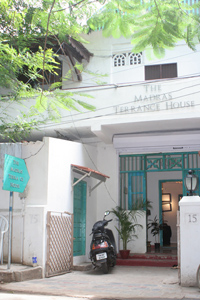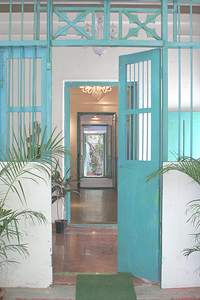|
You pause at the entrance to The Madras Terrace House, notice the thin, long bars on the doors and windows – and find yourself back in the world of summer holidays, grandparents, the fragrance of freshly-made bhakshanam and stories while being fed child-hand-sized portions of thair saadam. You look in; your gaze divides the house into two equal halves, cutting right through to the back door – reaching the Tulasi Madam with a jolt of recognition.

The entrance to the Madras Terrace House...
 ...And the view within. |
You walk in and, suddenly, it’s like another world has been very gently pasted over the old one – and it seems to fit just fine.
Kaveri Lalchand, actor with a social conscience, garment designer, publisher, and the moving force behind The Madras Terrace House, calls her brainchild “a place for cultural activities.”
The rooms and walls are filled with colour, augmented by a red Athangudi floor with its cheerful green and yellow border.
The contents of each room reflect the diversity of ideas and activities that are housed here. Sweeps of pink drapes run over and under old-fashioned rafters and, for a second, an image of a baby in a thooli flashes across your mind, before you notice the books published by Blaft Publications in a corner. Kaveri, along with Rashmi Devadasan and Rakesh Khanna, is a founder-director.
A brilliant red chandelier in the stairwell in the next room suddenly creates another mood. Artefacts are on scattered display, while the main passage acts as an art gallery. The inner large room, “which can take up to 60 people comfortably”, is used for discussions, theatre, movie screenings, book readings and releases, and the like.
The garage will soon become a kitchen, while the café – designed around a tea-kadai concept, serving traditional food – will be housed in the little garden area to the side and rear of the building.
Neighbour Ramiah Rajamohan of Shantha Publishers has been in the area since 1967.
“These are sets of twin houses,” he says, of his place and Terrace House. He recalls that way back then, “This was an area where vakils and doctors predominated” and claims that there are girders in Terrace House which were “brought down from England specially, and they still bear the mark of their manufacture.” He’s quite intrigued by the house’s new look.
A remark Kaveri made stands out: “Old houses have that sense of history, of stories within. That’s the fascination.”
And you decide to find out more about this house…
Your journey, you find, begins in 1903, when a young boy, K. S. Krishnaswami Iyengar, acquired a BA degree with Distinction at the Kumbakonam College, winning both the Beauchamp Scholarship and the Morris medal. Joining Law College, Madras, he took his Law Degree in 1906. In 1911, he ‘attached’ to Nugent Grant, who was very impressed by the young man’s hard work and analytical abilities. He then worked with Justice Coutts-Trotter as a junior, assisting him in bringing out a new edition of Mayne’s Hindu Law.
Krishnaswami Iyengar went on to become a very successful trial lawyer. He played a key role in the famous Temple Archakas case, which allowed him to display his extensive knowledge of Vaishnavite religious literature. A Sanskrit scholar, he established the Vedanta Siddha Sabha to promote Vedanta Desikar’s writings. He retired as a Judge of the Madras High Court in 1944. His knowledge of Hindu Law was profound. After retirement, he accepted the post of Chief Justice of the High Court of Cochin. He then went on to become a Senior Advocate of the Supreme Court. He retired in 1959.
His son, K. Raman, former Managing Director of Best and Crompton, Chennai, speaks of his father. “Around 1934-35, my father bought 1½ acres of land around the area where The Madras Terrace House is situated. The entire block belonged to him. He constructed three sets of twin houses, and a single house, for all his children. In addition, he built a number of houses within this plot, which were rented out – but my father hardly ever bothered about money and rent.” If he did collect rent, he would get maybe a total of Rs. 800 or Rs.900 for nearly 18 houses, Raman smiles. It cost Krishnaswami Iyengar Rs.7300 to construct each set of twin houses in those days, with a generous use of solid Burma teak.
“8 annas per ground,” laughs Raman.
Krishnaswami Iyengar passed away in 1973.
His granddaughter, Rekha Rangaraj, says: “I was very young at the time we lived in those houses. But, yes, it was like a huge, joint family. The twin houses were so much fun, with doors at the top of every staircase. You opened them – you were next door. There was free movement between the homes. The houses were occupied in the order of the siblings, eldest to youngest.”
She remembers, young as she was, Queen Elizabeth II’s visit to India in 1961. “The cavalcade travelled down Royapettah High Road, watched by the entire family, from their vantage point on the terraces.”
This particular house was owned by Raman’s brother Varadarajan. Each house was given a name, and the house known today as the Madras Terrace House was at that time called Manoranjan.
In the 1960s, life changed and the families decided to move. Raman says the area was no longer what it had once been….it was time to move on. Manoranjan was sold by Padmasini K. Varadarajan to Daniel Selvaraj. According to Rekha, three of the original seven houses still exist, with the Madras Terrace House being one of them. Prema Kasturi, Krishnaswami Iyengar’s daughter-in-law and retired Head of the Department of History at Women’s Christian College, Chennai, recalls details of her stay in that lane. “I have very pleasant memories of a lovely house, with verandahs.”
Shops, hotels have all replaced the mango trees and bougainvillea plants.
* * *
So, what led Kaveri Lalchand to The Madras Terrace House?
Her answer creates the impression that the many threads of her various interests and passions had but to come together in a concept like the Terrace House.
“A while ago, after thirteen years of being involved in the family garment manufacture and export business, I decided to take some time off. I worked in Bangalore with an NGO. This one year, in my thirties, changed my life. I came back in 2007, decided not to go back to my Ambattur factory, which has now been rented out. I had been in business since I was 23…it was time to do something else. I love people, and have no problem getting into conversations. I love Theatre. Cooking is another passion, and while I do experiment, I find that ultimately there’s nothing like traditional Indian cooking, especially South Indian cooking.
“I am part of the theatre group ‘Perch’. We are celebrating Vaikom Muhammad Basheer’s centenary year. In January this year, we performed Under the Mangosteen Tree. It was during this time that we began to feel that as smart, creative people, we needed to associate ourselves with service-oriented organisations….give something back.”
At this point, though, she still had no idea of starting something like the Terrace House.
She was essentially looking for office space, a place where she could display her custom-made clothing line. A broker answered her advertisement, and said that there was a building; it was a “little old” but would she be interested? She went across and saw a broken, cobwebby, locked house.
“It was in ‘a really bad state’. But I loved it. I know it sounds corny, but I walked in and felt really happy.”
The house belongs to Mr. Israel Selvaraj.
“We lived there for many years, from the 1970s,” he says. “My father, Daniel, bought it from Mrs. Padmasini Varadarajan. It was a nice, calm locality, not much traffic. We were like one large family. It’s all changed now. The house was shut down when we moved out. In 2008, I rented it to Kaveri.”
Mr. Selavaraj admits to having had many doubts about Kaveri’s venture. “It’s amazing how she’s totally transformed the house today. But, yes, I did have doubts.”
“He said not to take it… that no business could possibly flourish in such a location,” says Kaveri. “My father agreed with him. He took one look and snapped, ‘What is this rubbish’?”
But Kaveri was convinced. She was still thinking only in terms of a boutique, using the main hall for her machines, her embroidery units…
“But the minute that first coat of paint came up, I felt it was too selfish to keep it to myself.”
The house was crying out for a different kind of treatment, calling to be shared.
Her mind began to work…
“I asked myself why I should restrict myself to just one of my many interests. Imagine being able to create a place that would serve them all – garments, theatre, reading, cooking and, above all, social service. I believe in the concept of Seva. And I know there are many people out there who want to help, but do not know where to start. This could become a meeting place for those who want to help and those who need help to come together. I have begun dialoguing with organisations, running programmes. I will bring out a newsletter to let people know about the projects coming up. Now I am really acting on things, instead of just talking about them. It’s a dream come true. The symmetry of the house helps me focus my thoughts.”
Mr. Raman says: “For his time, my father was a very progressive man who believed that children should be independent. He would say: ‘You can stay here till you get married; after that you must be on your own.’ These houses were built specifically so that all his children could build their own individual lives.”
A line at the end of e-mails that emerge from The Madras Terrace House goes: The Madras Terrace House is a space for artistic expression & performance, a meeting ground for NGOs, a cafe, a store with customised clothing, Blaft Publications stuff and other interesting things.
This “typical agraharam house” seems comfortably cheerful in its new avatar, with the old philosophy – of nurturing ideas, dreams, and hopes – still in place.
(Location: No. 15, Sripuram II Street, Royapettah, Chennai -600 014)
|